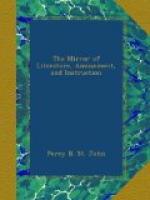Picture to yourself, reader, a square room of considerable magnitude, the walls of which, once white, have been blackened by every species of exhalation. Such is, in all its simple modesty, the aspect of a temple consecrated to the worship of Bacchus and Terpsichore. At first, by a very natural optical illusion, we are struck by the confined space before us, but the eye, after a time, piercing through the thick atmosphere of a thousand vapours which are most inodorous, the extent becomes visible by details which escape in the first chaotic glimpse. It is the moment of creation, all is bright, the fog disappears, becomes peopled, is animated, forms appear, they move, they are agitated, they are no illusory shadows; but, on the contrary, essentially material, which cross and recross at every moment. What beatitudes! what joyous life! Never, even for the Epicureans, were so many felicities assembled together. Those who like to wallow in filth, can find it here to their heart’s content; many seated at tables, on which, without ever being wiped away, are renewed a hundred times a day the most disgusting libations, close in a square space reserved for what they call the dancers. At the further end of this infected cave there is, supported by four worm-eaten pillars, a sort of alcove, constructed from broken-up ship timber, which is graced by the appearance of two or three rags of old tapestry. It is on this chicken coop that the music is perched: two clarinets, a hurdy-gurdy, a cracked trumpet, and a grumbling bassoon—five instruments whose harmonious movements are regulated by the crutch of Monsieur Double-Croche, a lame dwarf, who is called the leader of the orchestra. Here all is in harmony—the faces, costumes, the food that is prepared; a general appearance is scouted. There is no closet in which walking-sticks, umbrellas, and cloaks are deposited; the women have their hair all in confusion like a poodle dog, and the kerchief perched on the top of the head, or in a knot tied in front with the corners in a rosette, or if you prefer it, a cockade, which threatens the eye in the same manner as those of the country mules. As for the men, it is a waistcoat with a cap and falling collar, if they have a shirt, which is the regulated costume; breeches are not insisted on; the supreme bon ton would be an artilleryman’s cap, the frock of an hussar, the pantaloon of a lancer, the boots of a guardsman, in fact the cast-off attire of three or four regiments, or the wardrobe of a field of battle. The ladies adore the cavalry, and have a decided taste for the dress of the whole army; but nothing so much pleases them as mustachios, and a broad red cap adorned with leather of the same colour.
In this assembly, a beaver hat, unless napless and brimless, would be very rare; no one ever remembers to have seen a coat there, and should any one dare to present himself in a great coat, unless a family man, he would be sure to depart skirtless, or only in his waistcoat. In vain would he ask pardon for those flaps which had offended the eyes of the noble assembly; too happy would he be if, after having been bandied and knocked about with the utmost unanimity as a greenhorn, only one skirt should be left in the hands of these youthful beauties, who, in the fervour of gaiety, rather roar out than sing.




